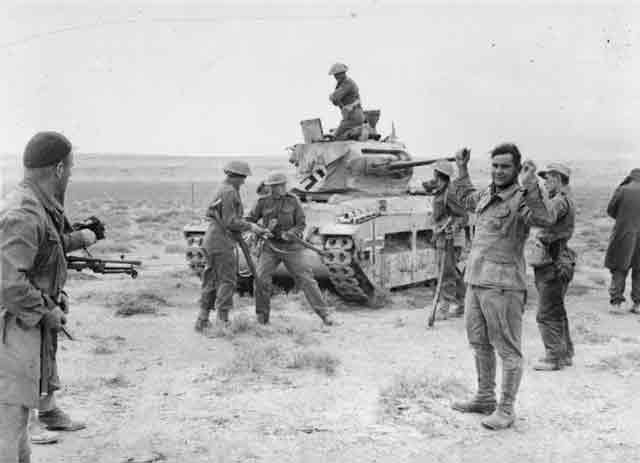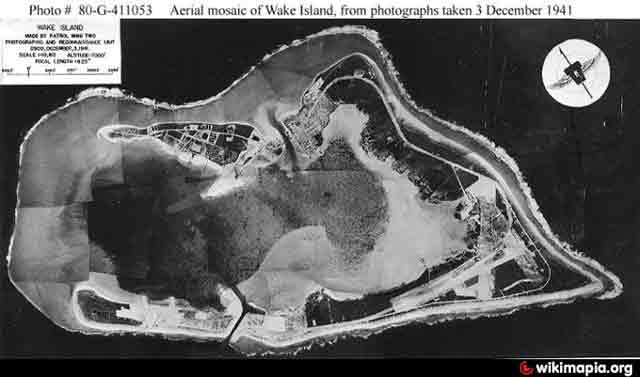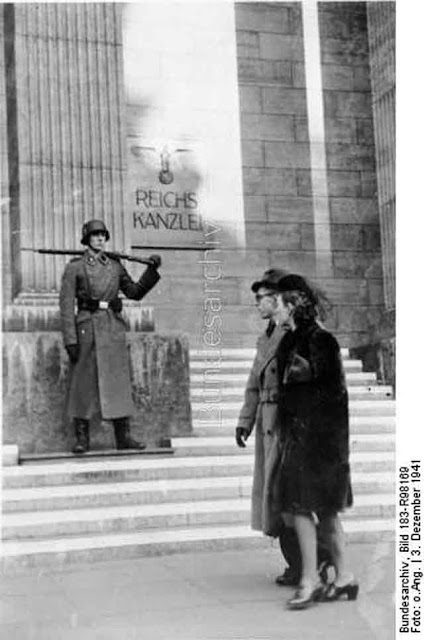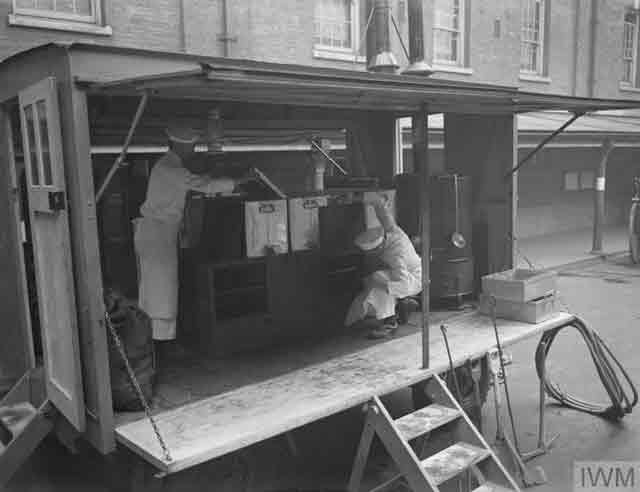Thursday 4 December 1941
 |
| "A U.S. Navy Vought SB2U Vindicator (42-S-17) of Scouting Squadron 42 (VS-42) returning to the aircraft carrier USS Ranger (CV-4) on 4 December 1941. Ranger was escorting a convoy in the Atlantic." (US Navy). |
Eastern Front: There have been many Soviet counteroffensives on the Eastern Front since the Germans invaded in June. On the whole, they have been futile, though one or two, such as at Yelnya in September, pushed the Wehrmacht back a bit. General Georgy Zhukov now has come up with one of the more ambitious plans, an attack by Red Army units both north and south of Moscow to drive the Germans back about 60 miles, but it requires Stalin's approval. In his memoirs, General Vasily Danilovich Sokolovsky, chief of staff of the Western Front, recalls that the final Stavka decision to mount this counteroffensive is made on
4 December 1941. As Zhukov recalls, the decision is made in a very off-handed way. Zhukov has a late-night telephone conversation with Joseph Stalin about general matters during which Stalin "reminds" Zhukov that the Kalinin Front would be going over to the counteroffensive on the 5th, while Southwest Front would follow the next day. This is the first that Zhukov, who more-or-less has been running the Red Army's operations, hears of it. And that is how the Moscow counteroffensive comes about.
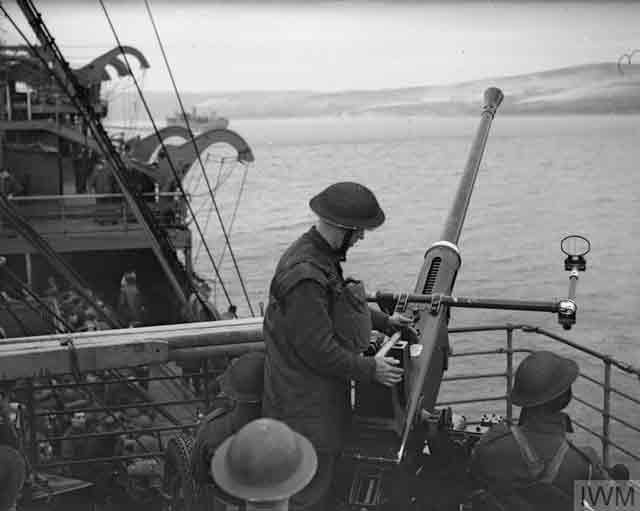 |
| "An anti-aircraft gunners at Action Stations during a mock air raid, while stores are being loaded from a transport." During combined landing exercises held on 3 and 4 December 1941 at Skipness, Scotland and aboard transport ship Winchester Castle. © IWM (A 6495). |
Conditions are ripe for a Soviet counteroffensive coming out of Moscow. The German troops have lost their momentum and they and their weapons are suffering from the extreme cold. While it is cold for the Soviet troops as well, they and their equipment are better prepared for it. In the morning, there are heavy snowfalls everywhere from the day and night before and the temperature stands at -4 °F, and Field Marshal Fedor von Bock records in his diary that it is "icy cold." After dark, the temperature drops to -25 °F, and a German regiment on a night march records over three hundred frostbite casualties and several wounded men freezing to death. In such conditions, the equipment that the Germans have used to get to Moscow and which for many serves as their home-on-wheels freeze. Their engines won't turn over, the guns won't fire because lubricants congeal, and hot food is impossible to serve in outdoor canteens. The Red Army has very small, but telling, advantages in all of these areas in part because the Germans are inhabiting areas that have been destroyed by fighting and supplied over unreliable lines of communication. The Red Army, on the other hand, holds positions that have not yet been fought over and which are served by longstanding and intact supply lines. So, the colder and frostier it gets, the more the balance of power swings to the Soviets.
 |
| "Western Desert, North Africa. 4 December 1941. Aircrew members of an RAF Squadron operating Glenn Martin Maryland bomber aircraft climb all over a British tank to examine it. Co-operation between the Allied air and land forces in the North African offensive has been excellent." (Australian War Memorial MED0155). |
Battle of the Mediterranean: The winner of the multi-week battle begun by the British Operation Crusader remains uncertain as of 4 December 1941. After some brilliant maneuvering by General Erwin Rommel, the German Afrika Korps has managed to push the bulk of the British Eighth Army back toward the Egyptian border. The British are far from defeated, however, and British 30th Corps to the south of Rommel's most advanced positions near Tobruk remains a deadly threat. Rommel spends the morning dividing his forces, sending 15th Panzer Division and Italian Ariete Division south toward the border while sending other troops against the British entrenched to the north at Ed Duda.
 |
| "Unloading petrol by means of a roller runway." Combined landing exercise held at Skipness, Scotland and aboard transport ship Winchester Castle. © IWM (A 6505). |
Neither attack succeeds. The British 70th Division's 14th Infantry Brigade at Ed Duda does not yield. The attack to the south alarms British Eighth Army headquarters, which orders British 4th Armored Brigade to the east (and weakens the British effort around Tobruk. However, the German/Italian attack stops after only a small advance at Gasr el Arid. At this point, Rommel decides to concentrate his forces in the south in order to hold off the main British power base. While the British at Ed Duda south of Tobruk remain a problem, he figures that if Afrika Korps can push the British back into Egypt, the Tobruk pocket will still be a pocket, albeit a much bigger one. That can be dealt with later. Meanwhile, the Italian Pavia and Trento Divisions on the Tobruk perimeter launch their own counterattacks against the 70th Division at Ed Duda which gain ground at the "Plonk" and "Doc" bunkers.
 |
| "Western Desert, North Africa. 4 December 1941. Remains of an Italian aircraft shot down near Qur el Beid being searched by a large number of Allied troops. The aircraft had been shot down during the second British Libyan offensive - Operation Crusader." (Australian War Memorial MED0153). |
US Military: United States aircraft carrier
USS Enterprise concludes a ferry operation to Wake Island, launching from 175 miles offshore to the north of Wake Island the last F4F Wildcats that it has brought to the island. It then turns back toward Hawaii, planning to arrive at Pearl Harbor on 6 December. Another dozen F4F-3 fighters of US Marine Squadron 211 also arrive at Wake Island today. The Americans don't know it, but the Japanese carrier striking force, Kido Butai, is steaming toward the east even further to the north of Wake Island and has its own aircraft nearby secretly observing the US air activities there. In the Philippines, General MacArthur orders General Lewis Hyde Brereton, the commander of the Far East Air Force who has just returned from twelve days in Australia, to institute air patrols north of Luzon. Brereton does this using short-range fighter planes which cannot patrol very far.
 |
| "Western Desert, North Africa. 4 December 1941. An RAF flying officer with a bandaged right arm, returned from a battle over Libya in which he shot down an Italian Savoia-Marchetti SM79 Sparviero bomber aircraft and a German Messerschmitt Bf109 fighter aircraft, with American correspondent Miss Morley Brook Lister." (Australian War Memorial MED0157). |
Japanese Military: A US PBY Catalina has been patrolling over French Indochina. Yesterday, it observed 30 Japanese troop transport ships in Cam Ranh Bay. Today, it sees none. The Japanese are heading south. In fact, Japanese forces leave today from many ports in order to get in position to invade multiple landing beaches in Malaya and Thailand.
Admiral Chuichi Nagumo's carrier striking force, Kido Butai, continues heading east in foul weather. The conditions help to keep the massive fleet safe from prying eyes. Kido Butai is following a virtually unused route to Hawaii that is far from the usual lanes to the south. Nagumo eventually will have to turn to the southeast in order to park about 200 miles north of Oahu. He plans on one more stop to refuel before making this turn.
 |
| "A Step In Front," a cartoon by Bill Mahony in the 4 December 1941 Sydney Daily Telegraph. It shows a bulldog sitting on a step (Singapore) looking out to sea under darkening skies. The Royal Navy is based at Singapore and is considered Australia's first line of defense. |
US Government: Congress adjourns as usual for the weekend. President Roosevelt is debating how to make one last plea to the Japanese to restart the moribund peace negotiations. Ambassadors Nomura and Kurusu continue meeting with Secretary of State Cordell Hull, but no progress at all is made.
Holocaust: At the newly opened Theresienstadt Concentration Camp in Czechoslovakia, Adolf Eichmann, leader of the RSHA section IV B 4 (Jewish Affairs), begins making the camp more efficient for its purpose as a transit camp. The German Generalplan Ost provides that all Jewish citizens of the Reich are to be sent to the East through processing camps such as Theresienstadt. Today, Eichmann appoints Prague native Jacob Edelstein, one of the early arrivals, to be the chairman of the Council of Jewish Elders (Judenrat) at Theresienstadt.
 |
| These are three of the twelve F4F-3 aircraft launched from USS Enterprise to land on Wake Island on 4 December 1941. While they are painted in peacetime conditions in this photo, during the journey to Wake they are repainted in a military scheme (US Naval History and Heritage Command). |
December 1941
December 1, 1941: Hitler Fires von Rundstedt
December 2, 1941: Climb Mount Niitaka
December 3, 1941: Hints of Trouble in the Pacific
December 4, 1941: Soviets Plan Counteroffensive
December 5, 1941: Soviets Counterattack at Kalinin
December 6, 1941: Soviet Counterattack at Moscow Broadens
December 7, 1941: Japan Attacks Pearl Harbor
December 8, 1941: US Enters World War II
December 9, 1941: German Retreat At Moscow
December 10, 1941: HMS Prince of Wales and Repulse Sunk
December 11, 1941: Hitler Declares War on US
December 12, 1941: Japanese in Burma
December 13, 1941: Battle of Cape Bon
December 14, 1941: Hitler Forbids Withdrawals
December 15, 1941: The Liepaja Massacre
December 16, 1941: Japan Invades Borneo
December 17, 1941: US Military Shakeup
December 18, 1941: Hitler Lays Down the Law
December 19, 1941: Brauchitsch Goes Home
December 20, 1941: Flying Tigers in Action
December 21, 1941: The Bogdanovka Massacre
December 22, 1941: Major Japanese Landings North of Manila
December 23, 1941: Wake Island Falls to Japan
December 24, 1941: Atrocities in Hong Kong
December 25, 1941: Japan Takes Hong Kong
December 26, 1941: Soviets Land in the Crimea
December 27, 1941: Commandos Raid Norway
December 28, 1941: Operation Anthropoid Begins
December 29, 1941: Soviet Landings at Feodosia
December 30, 1941: Race for Bataan
December 31, 1941: Nimitz in Charge
2020















